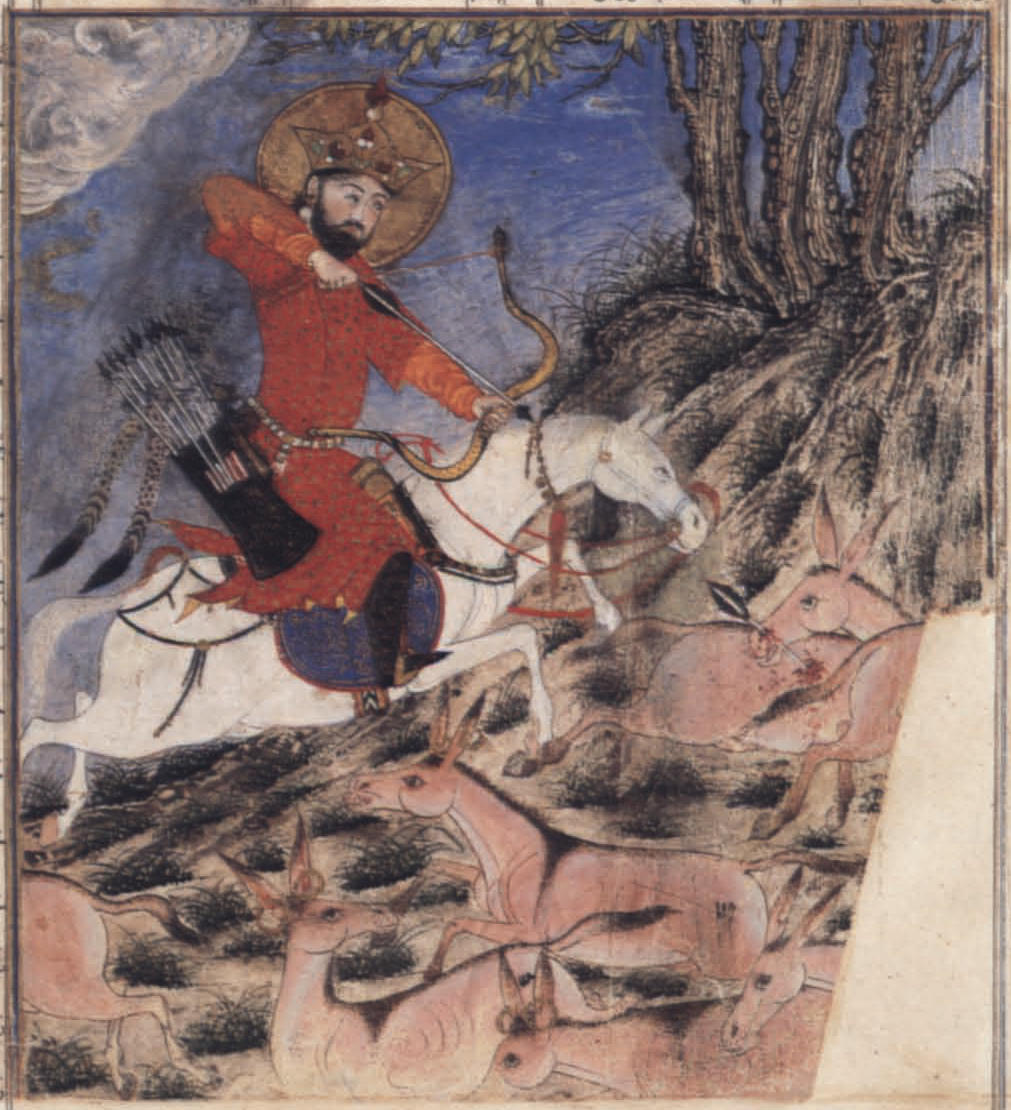
Create an Amazon Business Account
Ilkhanid Illustration
Great Mongol (Demotte) Shāh-Nāmeh
Chapter 35 - Bahram Gur (1) (63 years)
Bahram Gur hunts onagers
Tabriz, c.1335



57 Fig. 183
Bahram Gur Hunting Onagers
Image: 20 x 29 cm (7⅞ x 11⅜ in.)
Worcester Art Museum, Worcester, Mass., Jerome Wheelock Fund
(1935.24)
On another hunt, Bahram Gur astounded his companions with his skill by shooting at an onager so that the arrow entered the animalís rump and came out of its breast, and then by cleaving another in half with a single stroke of the sword. Pleased with his success and as a gesture of generosity, Bahram ordered six hundred onagers to be earmarked with gold rings and another six hundred to be branded, all to be distributed among the people.
Like other such scenes (see cat. no. 55), this one illustrates different moments in the narrative.1 Bahram Gur is shown with an arrow at the ready, while another has already hit its mark in an onagerís rump. Other onagers are seen with brands on their rumps and gold rings in their ears. The lower right corner is damaged and repaired with blank paper.
1. Grabar and Blair 1980, pp. 158-59, no. 51.
Source: pp. 156 & 257, The Legacy of Genghis Khan Courtly Art and Culture in Western Asia 1256-1353
Bahram Gur Hunting Onagers (Wild Ass), from the "Great Mongol" Shahnama ("Book of Kings") by Abu al-Qasim Firdawsi
about 1335
watercolor, ink, and gold on paper
60 x 40.5 cm (23 5/8 x 15 15/16 in.) Frame: 74.3 x 59.1 cm (29 1/4 x 23 1/4 in.)
Jerome Wheelock Fund
1935.24
Description: Bahram Gur, King of Persia of the Sassanide Dynasty, on horseback, hunting. King wearing a crown, head surrounded by halo of Byzantine saints, with Pahlavi characters inscribed on its edge. Shape of Mongol bow is worthy of note. Catalogue entry from "The Legacy of Genghis Khan" published by The Metropolitan Museum of Art. Cat. Entry #57: Bahram Gur Hunting Onagers. On another hunt, Bahram Gur astounded his companions with his skill by shooting at an onager so that the arrow entered the animal's rump and came out of its breast, and then by cleaving another in half with a single stroke of the sword. Pleased with his success and as a gesture of generosity, Bahram ordered six hundred onagers to be earmarked with gold rings and another six hundred to be branded, all to be distributed among the people. Like other such scenes, this one illustrates different moments in the narrative. Bahram Gur is shown with an arrows at the ready, while another has already hit its mark in an onager's rump. Other onagers are seen with brands on their rumps and gold rings in their ears.
Source: Worcester Art Museum, MA, USA
Worcester, Worcester Art Museum
Title of Work: Shahnama (Great Mongol)
Manuscript: 1935.24
Chapter 35 - Bahram Gur (1) (63 years)
Scene: Bahram Gur hunts onagers
English Title: Bahram Gur Hunting Onagers
Dimensions (h x w): 230 x 200 mm
Format: Rectangular within borders
Reconstructed Folio: 208v
Gregorian Date: 1335 (circa)
School: Tabriz
Source: Shahnama Project